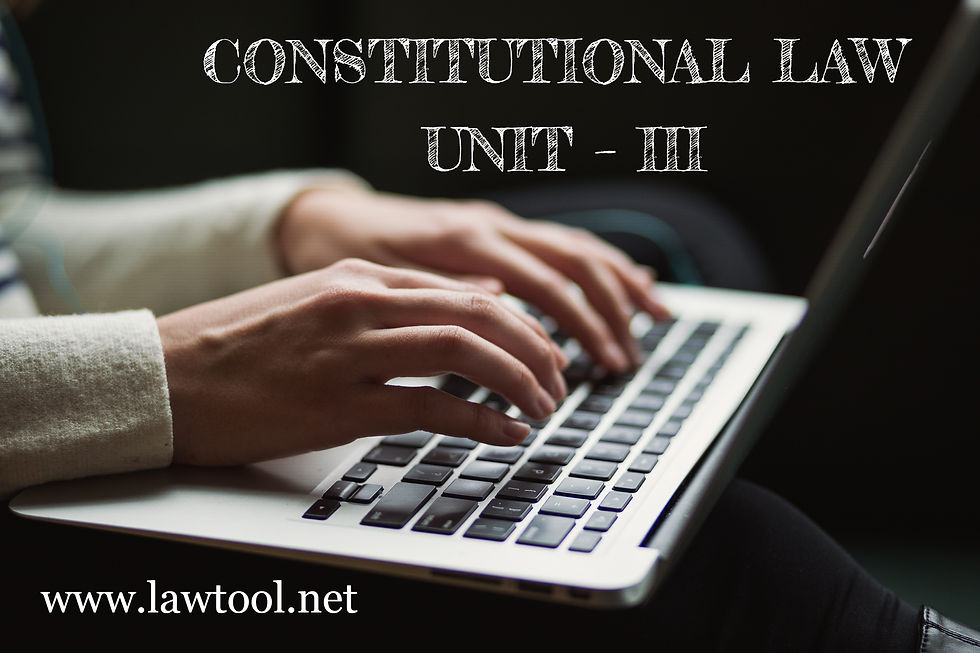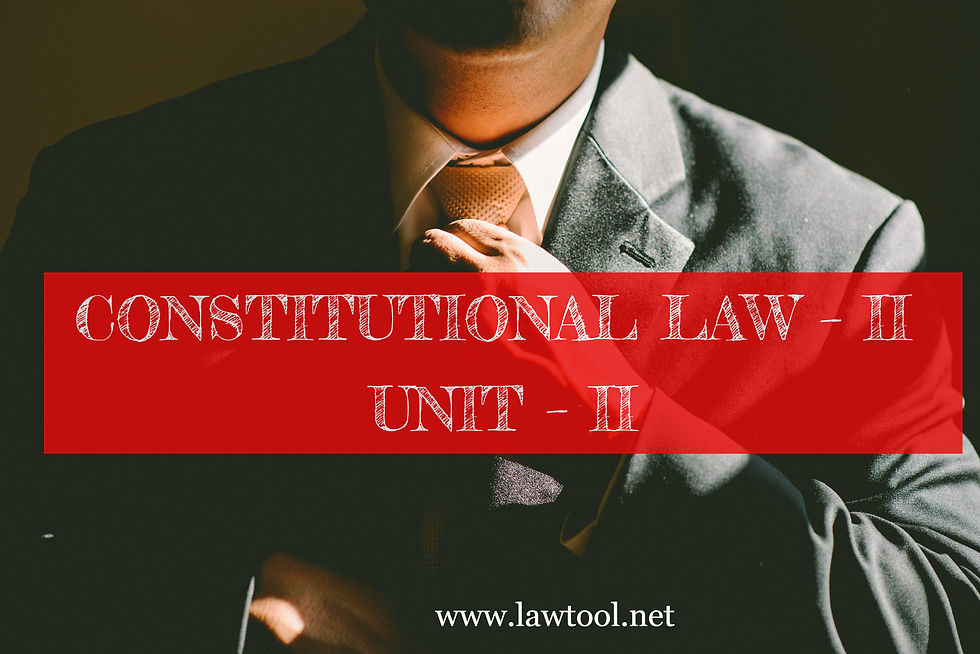CONSTITUTIONAL LAW UNIT – III
- www.lawtool.net

- 14 minutes ago
- 6 min read
The Right to Equality is among the most essential principles in the Indian Constitution, representing the values of justice and fairness in a society that is diverse and varied. Articles 14 through 18 lay down core elements of this fundamental right, touching upon areas such as gender, caste, and community. This post explores the importance and interpretation of these articles within India's legal framework, highlighting key judicial interpretations that have shaped both public policy and societal principles.
1. Concept and Significance of the Right to Equality
Article 14: Equality before Law and Equal Protection of Laws
The Right to Equality comprises several fundamental principles designed to govern the relationship between the state and its citizens. Essentially, these articles ensure that every individual receives equal treatment under the law and are protected against discrimination.
"The State shall not deny to any person equality before the law or the equal protection of the laws within the territory of India."
Two Components:
Equality before Law: A British (Rule of Law) concept — all are equal before the law.
Equal Protection of Laws: An American concept — similar treatment in similar circumstances.
1.1 Equality Before Law and Equal Protection of Laws
Article 14 guarantees that every individual, regardless of their status, is equal in the eyes of the law. This principle, known as "equality before the law," prevents the state from discriminating against any person. Article 15 strengthens this notion by explicitly prohibiting discrimination based on religion, race, caste, sex, or place of birth, mandating that all laws offer equal protection.
This legal guarantee is vital in dismantling systemic inequalities. For example, after the passing of the Prevention of Atrocities Act in 1989, there has been a significant reduction of approximately 30% in reported crimes against Scheduled Castes, reflecting the law's role in empowering marginalized communities.
1.2 Doctrine of Reasonable Classification
While ensuring equality, the state can classify individuals into different categories. However, these classifications must be reasonable and grounded in logic. The Doctrine of Reasonable Classification allows the creation of laws that address specific groups, provided they serve a legitimate aim that benefits the public. For instance, the government can provide special provisions for women in certain sectors to promote gender equality.
Doctrine of Reasonable Classification
The State can make classifications, but it must:
Be based on intelligible differentia.
Have a rational nexus with the object sought to be achieved.
Case: State of West Bengal v. Anwar Ali Sarkar (1952)Held that classification must not be arbitrary.
1.3 New Doctrine of Equality: Equality and Arbitrariness
Recent judicial interpretations have introduced a fresh take on equality through the lens of arbitrariness. The Supreme Court has been assertive in declaring that any law or action deemed arbitrary violates the Right to Equality. For example, in the case of Maneka Gandhi v. Union of India, the Court stated that arbitrary actions could not uphold a notion of justice, expanding the notion of equality beyond uniform application to fair and just treatment for all.
New Doctrine: Equality and Arbitrariness
E.P. Royappa v. State of Tamil Nadu (1974): Introduced the idea that arbitrariness is antithetical to equality.
"Equality is a dynamic concept with many aspects and dimensions..."
Maneka Gandhi v. Union of India (1978): Reinforced that arbitrary actions of the State violate Article 14.
2. Prohibition Against Discrimination
Article 15: Prohibition Against Discrimination
Articles 15 and 16 specifically prohibit discrimination. Article 15(1) bans discrimination based on religion, race, caste, sex, or place of birth, while Article 16 guarantees equality of opportunity in employment.
Prohibits discrimination on the grounds of religion, race, caste, sex or place of birth.
Important Clauses:
Article 15(1): Prohibits State discrimination.
Article 15(2): Prohibits private restrictions (e.g., access to public spaces).
Article 15(3)-(6): Allows special provisions for:
Women and children
Socially and educationally backward classes
Economically weaker sections (EWS) – Added by 103rd Constitutional Amendment (2019)
Case: State of Madras v. Champakam Dorairajan (1951) – Led to the 1st Constitutional Amendment to allow affirmative action.
2.1 Judicial Interpretation of Discrimination
Judicial interpretations have broadened the meaning of discrimination. In the landmark case of Indra Sawhney v. Union of India, the Supreme Court acknowledged that while affirmative action through reservations is important for uplifting marginalized groups, it should not lead to reverse discrimination. The ruling reinforced a balanced view during job placements, aiming to give underprivileged sections a fair chance while also protecting the rights of others.
3. Equality in Public Employments
Article 16: Equality of Opportunity in Public Employment
Article 16 endorses equality in public employment, ensuring no citizen is discriminated against when accessing public jobs.
Guarantees equality of opportunity in public employment for all citizens.
Key Clauses:
Article 16(1) & (2): General equality in public employment.
Article 16(3)-(5): Permits reservations for:
Backward classes (SC/ST/OBC)
Residents of a State
Posts requiring religious qualifications
Indra Sawhney v. Union of India (1992):
Upheld 27% OBC reservations.
Capped total reservations at 50% (subject to exceptions).
Introduced the "creamy layer" concept.
3.1 Judicial Pronouncements on Employment Equality
In several landmark rulings, like Kesavananda Bharati v. State of Kerala, the Supreme Court reasserted the importance of Article 16 and emphasized that discrimination in public employment contradicts the Right to Equality. This interpretation has pushed for inclusive employment policies, improving access to public positions for individuals from all backgrounds.
Moreover, the ruling in Vishaka v. State of Rajasthan initiated gender-sensitive policies to prevent sexual harassment at work, broadening the scope of equality beyond job access to maintaining a neutral work environment for all genders.
4. Abolition of Untouchability
Article 17: Abolition of Untouchability
Article 17 outright abolishes untouchability and bans its practice in any form. This provision is crucial for the social upliftment of marginalized communities, particularly those subjected to caste discrimination.
"Untouchability" is abolished and its practice in any form is forbidden.
Significance:
Declares untouchability a punishable offense.
Enforced through Protection of Civil Rights Act, 1955 and SC/ST (Prevention of Atrocities) Act, 1989.
People’s Union for Democratic Rights v. Union of India (1982):Supreme Court emphasized enforcing this right through legislative and executive measures.
4.1 Judicial Interpretation of Untouchability
Judicial interpretations have effectively challenged the remnants of untouchability in society. In the case of Champakam Dorairajan v. State of Tamil Nadu, the Supreme Court established that practices related to untouchability are taken seriously under the Constitution. These judicial efforts lead to more significant public awareness and highlight the importance of treating every person with dignity, irrespective of their social status.
5. Abolition of Titles
Prohibits the State from conferring titles (except military/academic distinctions).
Significance:
Prevents creation of an artificial aristocracy.
Citizens must not accept foreign titles without consent.
Balaji Raghavan v. Union of India (1996):The Court held that national awards like Bharat Ratna are not “titles” under Article 18 as long as they are not used as prefixes/suffixes.
Article 18 prohibits the state from granting titles, thereby preventing any associated privileges that come with hereditary titles. This ban is essential in a democracy that thrives on equality and fairness.
5.1 Judicial Perspectives on Titles
Judicial interpretations have reinforced the need for this prohibition as a crucial step in dismantling feudal hierarchies and promoting social equality. In Keshav Singh v. State of U.P., the Supreme Court stated that titles conferred by the state could lead to disparities among citizens, undermining the core tenets of equality and fairness.
Embracing the Spirit of Equality
The Right to Equality is one of the pillars of the Indian Constitution. Through progressive judicial interpretation — especially under Article 14 — Indian courts have continuously expanded the scope of equality to combat arbitrariness, ensure social justice, and uphold constitutional morality.
The Right to Equality defined in Articles 14 to 18 of the Indian Constitution is more than just legal text; it represents the aspirations of a society that seeks justice, dignity, and fairness for everyone. Through ongoing judicial interpretations and landmark instances, the application of these articles has evolved to tackle contemporary challenges while staying true to the ideals of equality.
To effectively navigate the complexities surrounding equality, individuals and the government must be aware of their rights and what they entail. Upholding the Right to Equality demands a collective commitment to fostering an inclusive society that celebrates diversity and actively works against all forms of discrimination.
By embracing vigilance, implementing proactive policies, and ensuring judicial enforcement, India can strive to achieve the true essence of equality for every citizen.










Comments